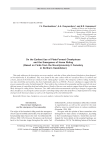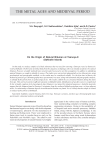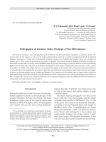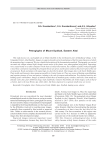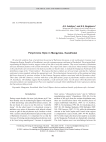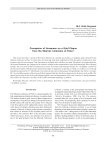The metal ages and medieval period. Рубрика в журнале - Archaeology, Ethnology & Anthropology of Eurasia
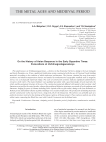
On the history of Asian Bosporus in the early Byzantine times: excavations at Verkhnegostagaevskoye
Статья
Бесплатно
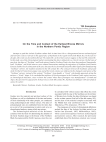
On the time and context of the earliest bronze mirrors in the Northern Pontic region
Статья обзорная
Бесплатно
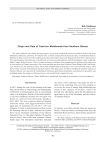
Origin and date of cast-iron moldboards from southern Siberia
Статья научная
The study addresses the dating and provenance of cast-iron moldboards found in Southern Siberia (the Altai Mountains, Khakassia, and Tuva). For the first time, a similar artifact from the Katanda valley, Ust-Koksinsky District, Republic of Altai, is described. The traditional idea that such artifacts date to the Tang epoch (618–907) is unwarranted. New interpretations of inscriptions on moldboards are proposed, indicating ties with the metallurgic center in Qiyang, Shahe County, Hebei Province, China. Certain specimens could have been manufactured in Qiyang, while others may be local replicas of Chinese prototypes. The closest parallels are those from Northern China, dating to 900–1400 (Song, Liao, Western Xia, Jin, and Yuan states). Those from Southern Siberia likely date to th e 13th–mid-14th century, when that territory was part of the Mongol and Yuan empires. The appearance of Chinese moldboards and their replicas in Southern Siberia was caused by the establishment of military-agricultural settlements, and progress in agriculture and metallurgy under the auspices of Yuan governors, who needed food to supply the army.
Бесплатно
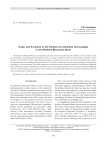
Origin and evolution of the earliest iron-smelting technologies in the Khakass-Minusinsk basin
Статья научная
The Khakass-Minusinsk Basin is archaeologically one of the best studied regions of Russia. Bronze artifacts from the pre-Scythian and Scythian epoch from that area are famous worldwide. However, iron production appears rather late there. From 2009 to 2018, a joint Russian-Japanese expedition excavated several sites documenting the earliest iron manufacture in the Khakass-Minusinsk Basin. On the basis of these excavations and experiments, metallurgical technology was reconstructed. The results suggest an evolutionary model of metal production in the Khakass-Minusinsk Basin during the Xiongnu-Sarmatian period. Three types of iron-smelting furnaces are described, structurally differing in terms of air-blasting and slag removal. The conclusion is made that the initial iron production technology had been borrowed, and later evolved in situ.
Бесплатно
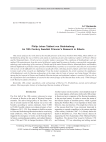
Philip Johan Tabbert von Strahlenberg: an 18th century Swedish prisoner’s research in Siberia
Статья научная
This article analyzes the work done by the Swedish prisoner of the Great Northern War Philip Johan Tabbert von Strahlenberg during his stay in Siberia and aimed at exploring ancient and traditional cultures of Western Siberia and the Minusinsk Basin. A brief overview of earlier studies is presented. The conditions of Strahlenberg’s work are outlined. His main interests, from his arrival in Siberia’s capital until his return to Sweden, concerned the cartography, ethnology, and archaeology of the environs of Tobolsk and of the entire Western Siberia, Minusinsk Basin, and Southern Siberian highlands in particular. Some episodes in Strahlenberg’s activities as a researcher and collector are described with a focus on the difficulties he experienced, specifically when collecting ancient artifacts and written documents. Certain results of his research are highlighted. From the modern standpoint, the article examines the significance of Strahlenberg’s work for Russian archaeology at the stage when its basis of sources was being formed. His place among the first experts in Western and Southern Siberian ancient and traditional cultures is assessed. The key role in the organization and consolidation of research in the remote fringes of the Russian State in the early 1700s belonged to the Russian Academy of Sciences.
Бесплатно
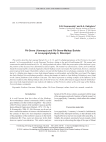
Pit-grave (Yamnaya) and pit-grave-maikop burials at Levoyegorlyksky-3, Stavropol
Статья обзорная
Бесплатно

Possibilities of direct dating of rock art in the Khakass-Minusinsk basin
Статья научная
The study addresses modern methods of absolute dating of rock art. We review prospective approaches to dating petroglyphs under various conditions: AMS, OSL, uranium-thorium, and cosmogenic isotope. Not so much methods per se are discussed as principles of their application to certain reliably dated rock art sites of various periods in Europe, Asia, America, and Australia. Examples of satisfactory outcomes in international practice are cited alongside our assessment of prospects and limitations to be considered with regard to the method of dating the earliest petroglyphs and rock paintings in the Khakass-Minusinsk Basin. The review suggests that the basic conditions for the use of the uranium-thorium method are not met, the AMS method requires a preliminary analysis of the context, whereas OSL and cosmogenic isotope method are the most prospective.
Бесплатно
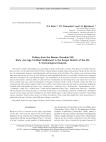
Статья научная
This article outlines the findings of a technological study of the Kulai ceramics from Barsov Gorodok III/6 near Barsova Gora, on the right bank of the Ob River, Tyumen Region, Khanty-Mansi Autonomous Okrug. We describe the site, its stratigraphic sequence and planigraphy, and the layout of the dwellings. The analysis was performed using binocular microscopy of traces in fresh transverse and longitudinal fractures of potsherds. Results were compared with those relating to the experimental sample. The examination of 50 specimens revealed a conservative tradition typical of the potters’ substrate skills. Its characteristics included the use of homogeneous clay mined near reservoirs in one and the same area, and the technology was based on bottom-to-body or body-to-bottom coiling. The body was constructed by side coiling. Adaptive skills were variable. Four mixed recipes for clay paste are described, making up one-fifth of the total number of recipes: clay + broken stone + chamotte; clay + broken stone + liquid organics; clay + + chamotte + sand; clay + broken stone + sand; and two unmixed recipes: clay + broken stone; and clay + chamotte. The mechanical processing of surface is variable, being based on 16 techniques and their combinations. Techniques used at various stages of pottery manufacture are listed. Simple paste recipes indicate groups of potters representing various traditions. Mixed recipes attest to a blend of traditions. Those using them might have been monocultural or multicultural groups of potters using different techniques and skills.
Бесплатно
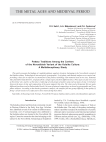
Статья научная
This article presents the findings of a multidisciplinary analysis of pottery belonging to the Novosibirsk variant of the Kulaika culture. Technological (traceological), petrographic, X-ray phase, and thermal analyses were carried out, providing a basis for an objective reconstruction of the pottery technology. Raw material used at two sites, Kamenny Mys and Dubrovinsky Borok-3, originated from a single region, but from different mines. Three types of clay were used at the former site, and two at the latter, evidencing several groups of potters using various types of clay. Correlation between the types of clay and composition of the paste supports this idea. The clays used at Kamenny Mys are quite different from those used at Dubrovinsky Borok-3 in terms of mineral composition, as shown by petrographic and X-ray phase analyses. According to the thermo-gravimetric analysis, the samples fall into groups differing in the quality of firing. Certain vessels were subjected to more intense firing than others.
Бесплатно

Prospection studies of Bohai graves near Kraskinskoye fortified settlement, Primorsky krai
Статья
Бесплатно
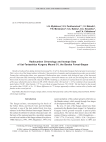
Статья научная
Results of radiocarbon dating of items from mound No. 51 of Ust-Tartasskiye Kurgany burial ground are presented. This is a key site of the Sargat culture in Baraba. Characteristics of samples and pretreatment procedure are provided. Twenty-four radiocarbon dates were generated. Radiocarbon ages correlate with biological ages of the deceased persons. Bayesian KDE chronology modeling suggests a short-term intense use of the site for burying those who died between the 3rd and 1st centuries BC. Based on MCMC-modeling, a conclusion is reached about two periods in the use of the space allotted for graves between 200–40 BC. Burials of the “first period” (~25 %) could have been repeatedly made before 150 BC. Most burials (~75 %) were likely arranged between 150–120 BC. The last burial in the mound (no earlier than 110 BC) is No. 13. Minor differences in 15N isotope apparently evidence various diets of males and females at the second period.
Бесплатно
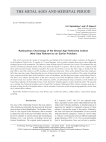
Radiocarbon chronology of the Bronze Age Fedorovka culture (new data relevant to an earlier problem)
Статья научная
This article presents the results of excavations and dating of the Fedorovka culture cemetery of Zvyagino-1 in the Southern Trans-Urals. It consists of 12 small kurgans, each of which contains from one to three differently arranged graves with cremations. The funerary items include typical Fedorovka clay vessels. We estimated the age of bones of domestic animals found on the area under the kurgan or in graves. The new dates were compared with those generated previously. Statistical analysis has made it possible to assess the time range as being from the mid-18th to mid-15th centuries cal BC (medians of calibrated intervals). Dates of the Alakul-Fedorovka complexes fall in the same time range, illustrating the process of interaction between these two traditions. The results of modeling were compared with the dates of the Andronovo sites in Kazakhstan, the Baraba forest-steppe, and Southern Siberia. The dates were similar, barring those of the more ancient series from Kazakhstan. Dates for the Alakul sites in the Trans-Urals were earlier (19th to 16th centuries cal BC), documenting the long coexistence of the Alakul and Fedorovka traditions. In the Southern Trans-Urals, the former tradition appears to have declined earlier. The question as to whether the Fedorovka tradition survived until the Cordoned (Valikovaya) Ware cultures remains open due to the lack of dates for the Cherkaskul culture, which resembles Fedorovka, while being stratigraphically earlier than the Cordoned Ware cultures.
Бесплатно

